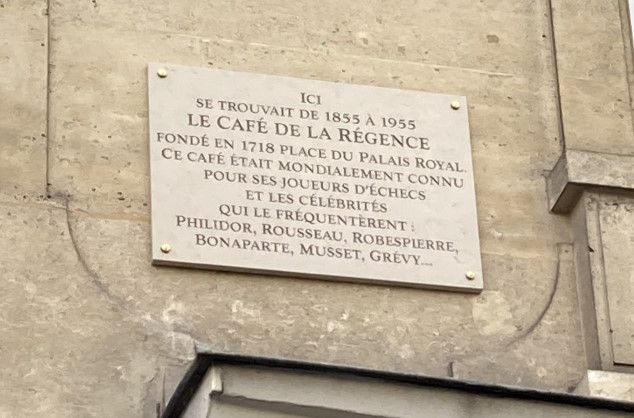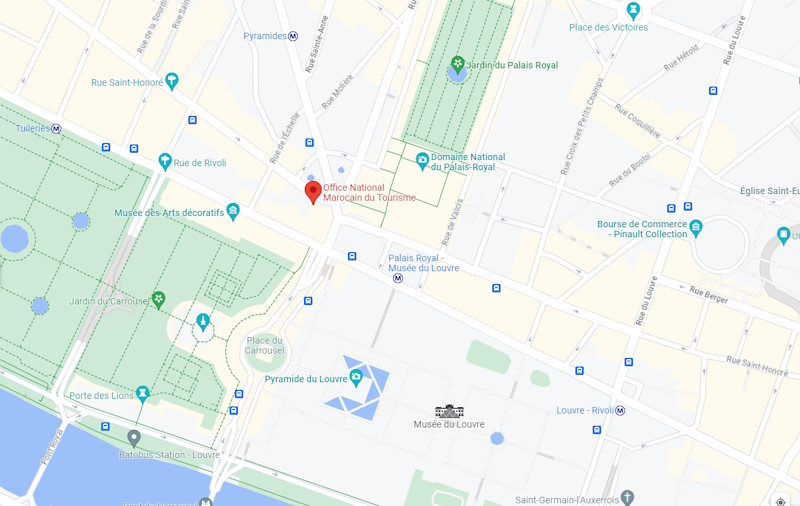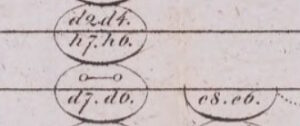Last updated on 2023-11-21
On November the 1st, I was walking in Paris and went to 161 rue Saint Honoré, where the Café de la Régence was located when Morphy visited Paris. The place is now occupied by the Office National Marocain du Tourisme (Moroccan National Tourist Office) but the following commemorative plaque is displayed on the building:

The text says: From 1855 to 1955, this was the site of the Café de la Régence, founded in 1718 in Place du Palais Royal. This café was world-famous for its chess players and the celebrities who frequented it: Philidor, Rousseau, Robespierre, Bonaparte, Musset, Grévy…
This plaque was installed there on April 4th, 2023, as related on the website of the French Chess Federation: Une plaque commémorative pour le Café de la Régence ! (echecs.asso.fr)
Here is where this is located in Paris, just close to the Louvre Museum and to the Palais Royal (map from Google maps):

The café de La Régence in the 19th century was described for example by George Walker in Fraser’s magazine of December 1840, page 669 (available online here).
Another description, in French, was published in 1862 by Alfred Delvau in Histoire anecdotique des cafés & cabarets de Paris, page 134 (available online here). Here’s the translation of the beginning of this text:
For provincials who have only been in Paris for a few years, or for Parisians who are just starting to push their way onto university benches, it would be difficult to imagine the Place du Palais-Royal as it was in 1849. It was a small square, decorated with a water tower occupied sometimes by municipal guards, sometimes by soldiers of the line. You got there via very ugly streets, muddy by day and barely lit at night: Rue de la Bibliothèque, Rue Froidmanteau, Rue Pierre Lescot, and a few others just as dirty, and just as ill-famed, where you stayed at night, and where I wouldn’t have wanted to stay during the day, even though wandering life had taught me not to be fussy. This had been going on for a long time, when February 24th and Napoleon III arrived. burned down the water tower, and Napoleon III ordered the Louvre to be enlarged and joined to the Tuileries. Today’s square no more resembles the square of yesteryear than the butterfly resembles the caterpillar.
The Caterpillar-Place was home to a highly reputed café that had been in operation for almost a century and a half, having opened in 1718, the year of Charles XII’s death and Cellamare’s conspiracy. Its name, café de la Régence, comes from the period itself; for three years, the old French monarchy, represented by Louis XIV, had died out at Versailles in the arms of Madame de Maintenon, and the abominable Cardinal Dubois reigned, under the name of Philippe, Duc d’Orléans and Regent. It was in this café de la Régence, where enthusiasts of the noble game of chess came every day, whatever the weather, hail or rain, wind or snow, a game that has more true ancestors than most of France’s greatest families; for it is no longer doubted that it was at chess, invented by Palamedes, that the Greek heroes gathered before Troy played: It is even claimed that this memorable siege, recounted by Homer, lasted ten years only because a game was being played that could not end, such were the chess skills of the warriors of the Iliad! Si non è vero….
As I’m not writing a history of the chessboard, but of the café de la Régence, I don’t need to go back to the flood to find my information: I’ll take the end of the 18th century, when Philidor was king.
The wood was pushed to the Café Procope, where the gallery formed around Jean-Jacques Rousseau and Philidor, engaged in a never-ending battle whose outcome was always unfavorable to the proud author of La Nouvelle Héloïse ; but he was pushed more particularly at the Café de la Régence, where the most diverse characters came in turn, Lemierre and Diderot, Voltaire and the Abbé de La Porte, d’Alembert and Poinsinet, the Emperor Joseph II and Rameau’s nephew, the Marshal de Richelieu and Jean-Baptiste Rousseau, Marmontel and the Marshal de Saxe, Chamfort and the Chevalier de Barneville, Saint-Foix and the Chevalier de la Morlière, Louvet and General Bonaparte, Champcenetz and Bernardin de Saint-Pierre, Franklin and the Marquis de Bièvre. Later, MM. Deschapelles, de la Bourdonnaye, de Jouy, de Forbin, General Duchaffaut, Dumont-Durville, Lacretelle, Jay, Percier, the painter Regnault, Champion (le petit manteau bleu), the architect Fontaine, Méry, who were happy to leave the club in the rue de Ménars to attend the games played by amateurs in the Place du Palais-Royal.
Among the chess players at the Café de la Régence, before 1848, was that lovable poet whom French letters were to lose so soon, Alfred de Musset, whose ordinary gallery included an old privateer, the respectable M. Blosse, bookseller on the Passage du Commerce, and an old actor, the respectable M. Provost, a member of the Théâtre-Français. On the afternoon of February 24th, he was starting a game with Delegorgue, the elephant killer, and he was beginning it with the classic scholar’s mate trick, imagined, it is said, by Paris, the happy shepherd of Mount Ida, when rifle shots inevitably interrupted it: King Louis-Philippe was checkmated by the Parisian people. Alfred de Musset was too much of a gambler to be moved by so little, and he would gladly have continued his game, which he already considered won, had not Delegorgue, in whom the warlike ardors had been reawakened at once, burnt his politeness to go and burn some primers on the Place du Palais-Royal with the National Guards who were taking away the Château d’Eau post.
The Café de la Régence was somewhat abandoned during the troubles that followed the proclamation of the Republic. Then, little by little, it recovered from such a hot alert, and its regulars, chess players and others, resumed their habits which, unfortunately, were once again violently interrupted by the expropriation for public utility that the Café de la Régence had to undergo. The reunification of the Louvre with the Tuileries had been decreed and begun, and, as a consequence, the surroundings of these two palaces had to be cleared: the Place du Palais-Royal completely disappeared, with its Château-d’Eau, its little streets and its old houses, and the present-day square was created!
It was a desolation for the old regulars of this branch of the Ménars circle, who had been coming there for so long, to whom the counter, the lady of the counter, the waiters, the tables, the chessboards, the players, everything was so familiar! But we had to resign ourselves to the fact that the city doesn’t play around with its expropriated customers once it has compensated them for the expropriation it has caused them. The regulars at the Café de la Régence agreed to move away, to leave their premises in the Place du Palais-Royal for a more elegant, more comfortable one, which the new owner had opened a few steps away, in the Rue Saint-Honoré, almost opposite the Rue Jeannisson, or rather quite opposite the square formed around the Théâtre-Français by the demolition of the right-hand side of the old Rue du Rempart.
[…]
Alfred Delvau in Histoire anecdotique des cafés & cabarets de Paris


Be First to Comment